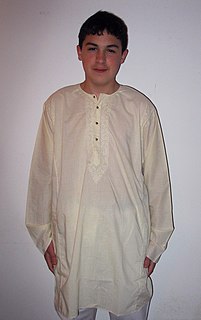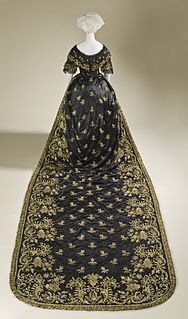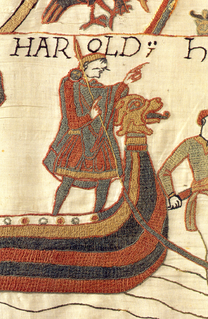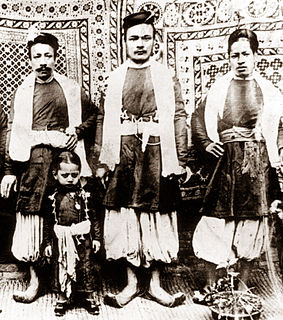Related Research Articles

A kurta is a loose collarless shirt worn in many regions of South Asia, and now also worn around the world. Tracing its roots to Central Asian nomadic tunics, or upper body garments, of the late-ancient- or early-medieval era, the kurta has evolved stylistically over the centuries, especially in South Asia, as a garment for everyday wear as well as for formal occasions.

A blouse is a loose-fitting upper garment that was worn by workmen, peasants, artists, women, and children. It is typically gathered at the waist or hips so that it hangs loosely ("blouses") over the wearer's body. Today, the word most commonly refers to a girl's or woman's dress shirt. It can also refer to a man's shirt if it is a loose-fitting style, though it rarely is. Traditionally, the term has been used to refer to a shirt which blouses out or has an unmistakably feminine appearance.

A chemise or shift is a classic smock, or a modern type of women's undergarment or dress. Historically, a chemise was a simple garment worn next to the skin to protect clothing from sweat and body oils, the precursor to the modern shirts commonly worn in Western nations.

A bathrobe, also known as a housecoat or a dressing gown, is a loose-fitting outer garment worn by people, often after a washing the body or around a pool.

Fashion in the period 1550–1600 in Western European clothing was characterized by increased opulence. Contrasting fabrics, slashes, embroidery, applied trims, and other forms of surface ornamentation remained prominent. The wide silhouette, conical for women with breadth at the hips and broadly square for men with width at the shoulders had reached its peak in the 1530s, and by mid-century a tall, narrow line with a V-lined waist was back in fashion. Sleeves and women's skirts then began to widen again, with emphasis at the shoulder that would continue into the next century. The characteristic garment of the period was the ruff, which began as a modest ruffle attached to the neckband of a shirt or smock and grew into a separate garment of fine linen, trimmed with lace, cutwork or embroidery, and shaped into crisp, precise folds with starch and heated irons.

The robe à la polonaise or polonaise is a woman's garment of the later 1770s and 1780s or a similar revival style of the 1870s inspired by Polish national costume, consisting of a gown with a cutaway, draped and swagged overskirt, worn over an underskirt or petticoat. From the late 19th century, the term polonaise also described a fitted overdress which extended into long panels over the underskirt, but was not necessarily draped or swagged.

A gown, from the Saxon word, gunna, is a usually loose outer garment from knee- to full-length worn by men and women in Europe from the Early Middle Ages to the 17th century, and continuing today in certain professions; later, gown was applied to any full-length woman's garment consisting of a bodice and attached skirt. A long, loosely fitted gown called a Banyan was worn by men in the 18th century as an informal coat.

In clothing, a train describes the long back portion of a robe, coat, cloak, skirt, overskirt, or dress that trails behind the wearer.

Anglo-Saxon dress refers to the clothing and accessories worn by the Anglo-Saxons from the middle of the 5th century to the eleventh century. Archaeological finds in Anglo-Saxon cemeteries have provided the best source of information on Anglo-Saxon costume. It is possible to reconstruct Anglo-Saxon dress using archaeological evidence combined with Anglo-Saxon and European art, writing and literature of the time period. Archaeological finds have both supported and contradicted the characteristic Anglo-Saxon costume as illustrated and described by these contemporary sources.

The Kho or Bakhu is a traditional dress worn by Bhutia, ethnic Sikkimese people of Sikkim and Nepal. It is a loose, cloak-style garment that is fastened at the neck on one side and near the waist with a silk or cotton belt similar to the Tibetan chuba and to the Ngalop gho of Bhutan, but sleeveless.

Traditional Newar clothing refers to the everyday clothes worn by the Newar people of Nepal who are indigenous to the Kathmandu Valley and surrounding regions. The garments are associated with the old aristocracy, merchants, farmers, craftsmen and professionals.

Punjabi Kurta and Tamba are traditional costume for men of Punjab.

Sindhi women wear the Shalwar kameez or the sari and the men wear the shalwar kameez or the kurta with pyjamma. However, before the adoption of the Shalwar kameez, the sari and the kurta, Sindhi's had their own traditional costumes.

History of clothing in the Indian subcontinent can be traced to the Indus Valley Civilization or earlier. Indians have mainly worn clothing made up of locally grown cotton. India was one of the first places where cotton was cultivated and used even as early as 2500 BCE during the Harappan era. The remnants of the ancient Indian clothing can be found in the figurines discovered from the sites near the Indus Valley Civilisation, the rock-cut sculptures, the cave paintings, and human art forms found in temples and monuments. These scriptures view the figures of human wearing clothes which can be wrapped around the body. Taking the instances of the sari to that of turban and the dhoti, the traditional Indian wears were mostly tied around the body in various ways.
Mughal clothing refers to clothing developed by the Mughals in the 16th, 17th and 18th centuries throughout the extent of their empire in the Indian subcontinent. It was characterized by luxurious styles and was made with muslin, silk, velvet and brocade. Elaborate patterns including dots, checks, and waves were used with colors from various dyes including cochineal, sulfate of iron, sulfate of copper and sulfate of antimony were used.
The term jama (Bengali: জামা) refers to a long coat which was popular in South Asia during the Mughal period.

Katzeb was an article of dress encircling the body, at the waist with ends hanging in the front. It was a kind of sash also called Patka.

Panchtoliya was an old cotton cloth of the Mughal period. The Panchtoliya was very light in weight and used for the veil. It was weighing only 2-5 tola per piece. The credit of Panchtoliya goes to the Mughal empress Nur Jahan. She was very fashion enthusiastic, encouraged, and introduced many styles and varieties of cloths of her interest. Few examples are Panchtoliya, badla, kinari, and Dudami weighing just two dams. Nur Jahan is also credited for specific dresses. For instance, nurmahali for the wedding is one of them.
Peshwaj was a ladies outfit similar to a gown or jama coat with front open, tied around the waist, having full sleeves, and the length was full neck to heels. Peshwaj was one of the magnificent costumes of the mughal court ladies. The material was used to be sheer and fine muslins with decorated borders of zari and lacework.
Yalek was an underslip, a ladies garment older than 500 years of the Indian subcontinent. Yalek was a long vest type undergarment, sticking to the body, and the length was down to ankles. The ladies wore Yalek underneath the gowns and other costumes. Both Hindus and the Muslim ladies wore similar dresses except few changes.
References
- ↑ Mukherjee, Soma (2001). Royal Mughal Ladies and Their Contributions. Gyan Books. p. 83. ISBN 978-81-212-0760-7.
- ↑ RAWAT, DR SUGANDHA (2020-07-20). THE WOMEN OF MUGHAL HAREM. Evincepub Publishing. p. 82. ISBN 978-93-90197-41-5.
- ↑ Liddle, Madhulika (2012-11-30). Engraved in Stone: A Muzaffar Jang Mystery. Hachette India. ISBN 978-93-5009-456-3.
